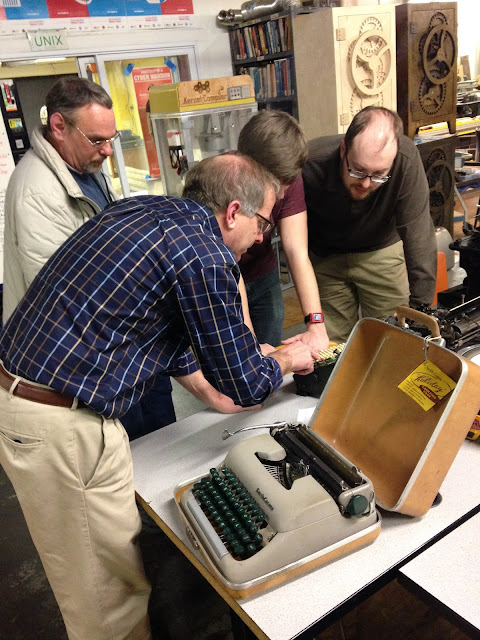The type-in at Barnes & Noble in Boston's Prudential Center last weekend was an extensive affair ...

... ringing with the happy sound of mechanical writing machines.
My visit to Boston was an eventful one: I read a paper at the American Comparative Literature Association conference at Harvard, and met various interesting people there; I spent time with old friends; I visited historic sites and antique shops; I stuffed myself with good food; and of course, I attended the type-in and book signing.
Even before the event, I scored some typewriter jollies. One antique shop had several shelves of the machines (unfortunately, overpriced and sometimes gummed up):

A café in Cambridge featured these three beauties in a display case:

And in a Concord curio shop, a beautiful volume of
La Nature from 1877 featured an article on the Sholes & Glidden:

I suppose the Type Writer must have seemed as exotic and implausible as this velocipede.

But on to the type-in. The shop had plenty of copies of my book on hand; I read from the section on letter writing and signed some books.

I soon got to meet various delightful people, including Abraham S. (left in the photo below, author of
La Vie Graphite) and Emma Furrier (center, daughter of Tom Furrier of Cambridge Typewriter,
whose post on the type-in you can find here).


The venue was found by Arthur Grau (at left in the photo above), who also brought the greatest number of machines. Arthur, who recently moved to Boston from Hawaii, runs
The Type Bar, offering "hand typed letter art mailed anywhere." Arthur is featured in my book along with the former name of his project, Universal Babel Service. It was a real pleasure to meet him.
Here's Tom Furrier typing his blog on a beautifully restored Corona Four that he brought for the event.

The machine has a fresh platen and looks like it's straight from the factory.
Abraham brought his handsome and trusty Olympia, which has been blessed at a Welsh monastery:
Some typewriters were less handsome but still trusty, such as this Royal Tab-O-Matic made in Japan:
I brought an Empire Aristocrat (which felt a little awkward in the home of the American Revolution), equipped with carbon ribbon.
But the machine that really caught my attention was this Erika M, brought by local college student Michael. I've been looking for an M with a QWERTY keyboard, like this one. They didn't make portable typewriters finer than this.
But back to the humans. The Erika was enjoyed by some appreciative girls.


Quite a few participants brought their favorite typewriters for the event. Other people of all ages stopped by to check out the commotion, and often got absorbed in the typing.







All told, this was a great event that reaffirmed my faith in the power of the typewritten word.


Arthur, me, Tom, and Abraham (photo courtesy of Abraham)




























































